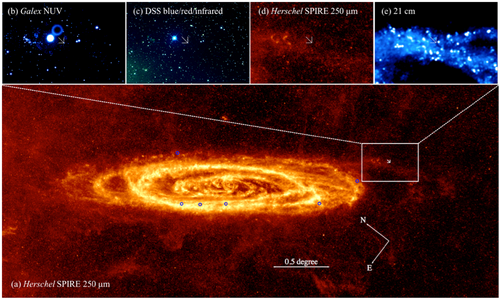A study by the research group led by Prof. Xiaowei Liu from Yunnan University and Prof. Huawei Zhang from Peking University presents the discovery of a new Luminous Blue Variable (LBV) in the outskirt of the Andromeda Galaxy (M31), using data from the LAMOST spectroscopic surveys from the Xinglong NAOC 2.16m, Lijiang YNAO 2.4 m optical telescopes, and the archival data. The finding has been published by The Astrophysical Journal Letters.
LBVs are hot, unstable, massive (> 25 – 30 solar mass) and extremely luminous (105-107 solar luminosity) evolved stars in the upper left parts of the Hertzsprung-Russell (HR) diagram. During the LBV phase, massive stars undergo episodes of eruptive mass-loss (10^5-10^4 solar mass per year), accompanied by spectacular photometric and spectral variabilities, on timescales of years to decades or longer. The origin of the eruptions is not yet well understood, partly due to the limited number of confirmed LBVs and the rareness of the eruptions. From the quiescence to the outburst (or eruptive) stage, the brightness of an LBV increases by 1 – 2 mag in the visual band and the spectrum type changes from O/early-B to A/F.
At present, the LBV is either considered as a transition phase between the main sequence massive stars and the Wolf-Rayet stars or is an intermediate precursor of a supernova. More recently, some studies show evidence propose that LBVs could be evolved blue stragglers, i.e. the products of binary evolution, although this is still hot debated. Discovery of new LBVs is therefore of vital importance for understanding the origin of the eruptions and the role LBVs play in stellar evolution.

Figure: Images in the different bands showing the location and environment of LAMOSTJ0037+4016. Panel a: Herschel SPIRE 250μm image. The image scale is shown near the mid-bottom. The six blue circles mark the locations of the previously known LBVs in M31. The white box of size 20’×30’ is centred at this newly discovered LBV. The four images on the top zoom in on the area (of the same size of the white box) of LAMOSTJ0037+4016 in Galex NUV band (panel b); in DSS blue, red and infrared color composite image (panel c); in Herschel SPIRE 250μm image (panel d) and in 21cm line image (panel e).
Currently, only six LBVs are identified and all of them are located in the spiral arms or star forming rings of the M31 disk (see Fig. 1). Using the optical light curve, the multi-epoch spectra and the near-infrared color-color diagram, we have identified the seventh LBV of M31. More interestingly, this new LBV is located near the south-western corner of M31 with an unexpectedly large projection distance of 22 kpc from the center. Follow-up observations of this special LBV and its environment may provide vital constraints on the evolutionary status of LBVs.

Address: 20A Datun Road, Chaoyang District, Beijing, China code: 100012
Tel: 010-64888708 E-mail: naoc@nao.cas.cn

